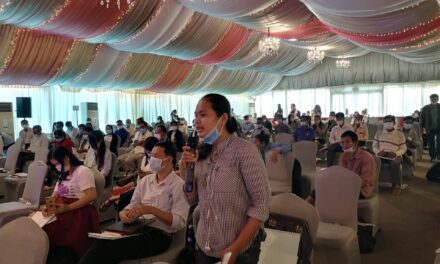[Montemayor is the party-list representative of the Alyansamg Bayanihan ng mga Magsasaka, Mang-gagawang-Bukid at Mangingisda (Cooperative Alliance of Farmers, Farmworkers, and Fisherfolk. He delivered this privileged speech at the Philippine House of the Representative on 18 August 1998.]
The GATT-Uruguay Round met stiff opposition from many small farmer organizations when it was presented to our Senate for ratification in 1994. There was very limited consultation beforehand, and it was obvious that the agricultural sector was generally unprepared to compete with foreign producers in both the domestic and foreign markets. The lack of the basicinfrastructure and support services to Filipino farmers made their production and marketing costs extremely high. This raised fears that the opening up to the local market to cheaper imports would effectively deprive our farmers of their livelihood. Additionally, many provisions of the GATT-UR were deemed to favour only developed and exporting countries. There were also concerns that an increasing dependence on imports for basic food products would threaten the food security and socioeconomic stability of the country in the long run.
The Philipppine Senate nevertheless decided to ratify the GATT-UR and the country’s membership in the World Trade Organization (WTO). In response to the concerns earlier raised, it likewise endorsed a four-year 130 billion peso master plan prepared by the executive department. The plan would establish “safety nets” for sectors that would be adversely affected by the trade liberalization program and provide supports measures to improve the competitiveness of local producers. Initial tariff rates were also set to as high as 100 percent for sensitive farm commodities that previously enjoyed quantitative restrictions. Like Japan and South Korea, the Philippines invoked Annex 5 of the Agreement on Agriculture to exclude rice from the tariff program.
It has been almost four years since the ratification of the GATT-UR. Preparations are now under way for the next round of negotiations, which will determine the directions for agricultural trade beyond 2004. In the Philippines this has again elicited concerns on the preparedness of our agricultural sector. A large portion of the funds promised under the master
plan were not actually delivered, partly due to budgetary constraints. With the current economic crisis, future support to agriculture will likely be even more inadequate. There have also been inefficiencies in fund usage and difficulties in project implementation.
Many of the defects and weaknesses that were highlighted during the 1994 debates still exist and continue to render our farmers uncompetitive. Admittedly, there are internal problems which we should attend to, with or without GATT and WTO. Today, we may have no choice but to carefully calibrate the opening up of our markets so that we can gain enough time to
overcome our problems and give our farmers a fair chance to survive in the global market. To do otherwise would be tantamount to economic, social and even political suicide, considering that our agricultural sector consists of millions of families who depend on small-scale farming for their livelihood.
Given this situation, the biases of the current trade agreement against developing countries must be corrected. Our attempts to develop the Philippine agriculture and our farmers more efficient and competitive will be futile if their countries are able to dump cheap, subsidised produce and, at the same time, restrict the entry of our exports through various non-tariff barriers. Hence, the next year’s round of WTO negotiations in agriculture, the primary focus should not be on greater liberalization by developing countries but on making international trade fairer. We must likewise ensure that the benefits from liberalization are more equitably shared among developing and developed countries.
In the case of tariff and market access, there are moves to further reduce tariffs below the 2004 ending rates. Another proposal seeks to phase out the minimum access volume or tariff rate quota system for sensitive commodities, either by expanding the required volume of accelerating the reduction of our quota tariffs. There is also a suggestion to remove the
special safeguard provisions that allow for a temporary tariff adjustment in the case of an abnormal increase in the volume, or a decrease in the price, of imports, of selected commodities. The continued exemption from tariff of staples, such as rice, is also being questioned.
On the other hand, the suggested review of tariff-rate structures is helpful. The GATT-UR provisions allowed many countries to continue protecting selected sectors, sometimes even more strongly than when quantitative restrictions were in place. Under the agreement developed countries were supposed to reduce average tariffs by 36 percent over six years, while developing countries committed to a 24-percent cut over 10 years. However, because the mandatory reductions were simple, instead of weighted, averages over tariff lines, it became easy to maintain high tariffs for favoured commodities and compensate for these by lowering tariffs faster for less sensitive products. With extremely high out-quota tariffs, the quantitative restrictions were effectively retained under the guise of the minimum-access-volume scheme (MAV), which restricts the quantity importable at affordable tariff rates.
The proposal, however, to correct the distortions by lowering tariffs to near-zero levels and phasing out the MAV system are simplistic. They fail to address other issues that force countries to adopt high tariff rates in the first place. For instance, developed countries that extend huge subsidies to their producers and exporters will obviously gain the most from lower tariffs. In turn farmers in developing countries, which do not have the resources to provide similar support, will be more at risk. Reducing tariff protection by itself does not guarantee a level playing field in international trade.
The GATT-UR requires only a partial and, in fact, minimal reduction in domestic support measures. A developed country, for example, that provides a 30-percent subsidy to its farmers is obliged to reduce this by 20 percent over six years. It can therefore legally retain 24-percent subsidy level. On the other hand, a developing country with few or no subsidies cannot
extend subsidies exceeding 10 percent of the local production value, assuming it musters the capacity to do so. Moreover, the mandatory reductions are unweighted so that domestic support can effectively be retained and even increased for certain favoured products while offsetting this with decreases for non-critical commodities.
The domestic support measures that are subject to reduction do not include other types of support that could be trade-distorting. A major concern is the exempt “blue box” category, which allows many developed countries to give direct payments to their farmers under certain production-limiting programs. There are also no limits on expenditures for basic
infrastructure, general support services and income support to producers which is not linked to production and prices. This has given developed countries ample leeway to evade reduction requirements by reconfiguring their domestic support to measures that are not subject to cuts. Furthermore, many countries were able to overstate their levels of domestic support or adopt a base year during which support levels were at their highest. This has enabled them to effectively retain most of their programs even after complying with their reduction commitments.
In the case of export subsidies, many developed countries have managed to retain their edge over developing countries, which cannot afford to give such support. The GATT-UR provided for only a partial slash in the volume of subsidised products and budgetary outlays for export subsidies. By imposing a ban on subsidies, the GATT-UR also restricted developing countries that previously could not afford export subsidies from introducing any such measures in the future.
As with domestic support, the mandated cuts in export subsidies were simple and unweighted averages which allowed countries to maintain support for their major export products. Moreover, countries could select a base year, during which export subsidies were at high levels. Aside from these, some developed countries have reconfigured their export subsidies into domestic support measures that are not subject to reduction. This may explain why they appear open to decreases in export subsidies but are silent on domestic-support measures. Others have devised ingenious schemes, such as allegedly GATT-legal export credit and food aid programs that enable them to sell their surpluses at below market rates.
Generally speaking, therefore, the current trade agreement has failed to correct the imbalance in the terms of trade between developed and developing countries, particularly in domestic support and export subsidies. In such a
situation, further liberalization through tariff reductions will only exacerbate this inequality and heighten the edge of developed countries. Obviously, developing countries like the Philippines that have extremely limited capability to support their farmers will be at a severe disadvantage.
Other equally important issues need resolution in the forthcoming WTO negotiations. The GATT-UR provisions intended to harmonize sanitary and phytosanitary measures have ironically led to the proliferation of “equivalent” quarantine regulations that are being used to arbitrarily block the entry of imports, many of them from the developing countries. Concerns have also been raised on the possible use of the agreement on trade-related aspects of intellectual property rights to monopolize ownership of critical technologies, planting materials and organisms to the disadvantage of users in resource-poor developing countries. The introduction of labor and environmental standards as allowable trade barriers may lead to the
rejection of exports from less developed countries.
In the final analysis, any agreement on the trade of goods and services must benefit our people. For developing countries the 1999 WTO round on agriculture will be critical to the survival and prosperity of their farmers, who continue to compromise the bulk of their populations and economies. Let us therefore make sure that the results of these negotiations will not only lead to freer trade but, more important, to trade that is fair and beneficial to all.








